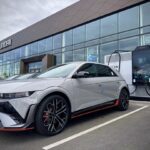After a decade of slow growth in the U.S., we’re now seeing an acceleration curve for electric vehicle (EV) adoption, with major auto manufacturers like Ford, Tesla, and Volkswagen coming to market en masse with fully electric vehicles. In short, the EV market is really having its moment in America following President Biden’s Infrastructure Investment and Jobs Act, part of which grants the Department of Transportation $7.5 billion to invest in building out a national EV charging network. This marks a great dawn of EVs, and with that projected proliferation, we’ll get to see the true impact of EV charging infrastructure on the electric grid in 2022.
This acceleration relies heavily on having the EV charging infrastructure in place to support it—and, by extension, the electric grid. As we climb toward 2023, the new and specific pull of EVs on the grid will finally show real impact.
One of the most common questions is: can the grid handle it? And after 100+ years of robust use and dramatic changes, the question is warranted. The rise of air conditioning, inflation on generation plants, the reduction of nuclear power, and the rise of renewable energy have all made a lasting impact. Now, we can and must implement a new change to deal with the next macro-level impact to the grid—electric vehicles.
We can’t just wait and watch this happen. A strategy of reaction will be capital intensive, slow, and will have a high impact in our own backyards. Instead, let’s fully—and proactively—embrace the innovation of electrified transportation in 2022.
With the rise of Vehicle-to-Home (V2H) and Vehicle-to-Grid (V2G) technologies, for example, EVs can now become more than just the latest energy load on the grid, in which we react. Rather, the transition can represent the moment when at-scale bidirectional and renewable energy hit pace in the U.S. infrastructure. EVs and EV infrastructure can be more than a challenge, they can be part of the solution—and will evolve into a critical grid asset.
Now, this is not the first time the grid has reacted to newer “non-wire alternatives.” In fact, over the past decade, we’re getting progressively better at handling the opportunities and the complexities of a smart grid. Smart meters have helped to create a grid network with amazing transparency and flexibility. The rise of “prosumer” programs, or those that allow the consumer to also produce electricity, have helped stabilize and integrate renewable energy, and have allowed individual assets such as thermostats and smart appliances to selectively help the grid.
Similar to many of these previous trends, V2G is both a technology and a new market enabler. With this technology running at-scale, charging and discharging energy equal to the whole demand of a home will be possible on the edge of the grid. And this transition will enable new business models of resiliency, grid stability, assistance in natural disasters, and new economic opportunities.
Further, the addition of V2G at scale will also provide several unanticipated benefits—it will actually help our grid add more clean renewable power and offer new opportunities for vehicles to be a part of energy saving strategies. The combination of the transportation and electrical sectors will make both stronger.
And why I’m most excited: what once started as a science experiment is actually available right now. It’s an amazing step in the right direction, bringing new value to consumers, a new business model to original equipment manufacturers, a new sense of support for utilities, and a new source of stabilization for the grid. So, 2022 is the year that V2G finally happens.
—John DeBoer is head of Siemens eMobility North America.









